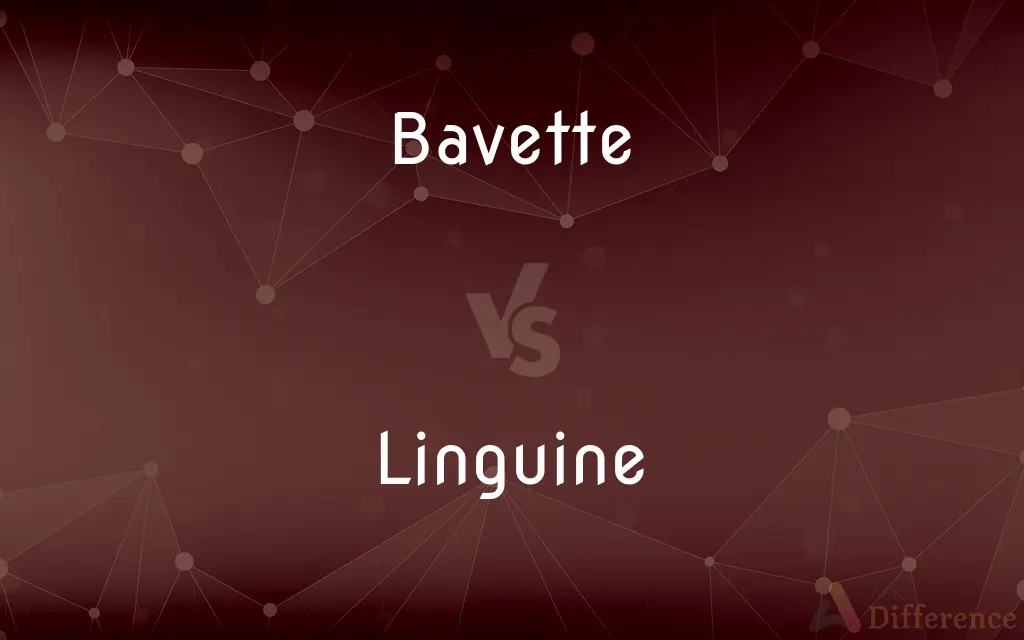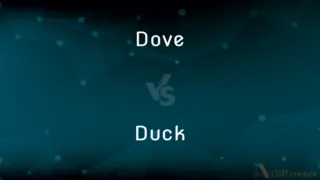Bavette vs. Linguine — What's the Difference?
Edited by Tayyaba Rehman — By Fiza Rafique — Updated on October 25, 2023
Bavette is a flat pasta similar to fettuccine and originates from Genoa, while linguine, also flat but narrower, comes from the Liguria region of Italy.

Difference Between Bavette and Linguine
Table of Contents
ADVERTISEMENT
Key Differences
Bavette is a type of pasta known for its flat and wide nature, akin to fettuccine. This pasta style can be traced back to the region of Genoa in Italy. On the other hand, linguine, another variety of Italian pasta, is distinct with its flattened and slightly narrower structure. Linguine’s roots are deeply tied to the Liguria region of Italy.
Both Bavette and Linguine are celebrated components of Italian cuisine and are often mistaken for each other given their visual similarities. However, their distinctions, albeit subtle, are appreciated by pasta enthusiasts. Bavette typically pairs with heartier sauces due to its broader surface, while linguine, with its slightly slimmer profile, is commonly served with lighter sauces, especially seafood-infused ones.
Despite their differences, both Bavette and Linguine offer versatile options in the culinary world. Bavette, with its robustness, stands strong in rich dishes, delivering an authentic Genoese experience. Linguine, on its end, gracefully complements dishes, ensuring the flavors of the Liguria coastline are well represented.
A journey through Italy’s diverse regions and their unique pasta varieties is incomplete without savoring the textures and tastes of both Bavette and Linguine. While Bavette reminds one of the bustling lanes of Genoa, Linguine transports its savorer to the serene Ligurian coasts.
Comparison Chart
Origin
Genoa, Italy
Liguria, Italy
ADVERTISEMENT
Shape
Flat and wide, similar to fettuccine
Flat and narrow, between spaghetti and fettuccine in width
Common Pairings
Heavier sauces
Lighter sauces, often seafood-based
Texture
Robust, holding up well with richer sauces
Delicate, complementing subtle flavors
Regional Representation
Represents the culinary style of Genoa
Exemplifies the flavors of the Liguria coastline
Compare with Definitions
Bavette
An Italian noodle similar in appearance to fettuccine.
She prepared a hearty meat sauce to accompany the bavette.
Linguine
Positioned between spaghetti and fettuccine in terms of width.
For those who can't decide between spaghetti and fettuccine, linguine offers a middle ground.
Bavette
A flat and wide pasta originating from Genoa.
Bavette with pesto is a traditional Genoese dish.
Linguine
A narrow, flat pasta from the Liguria region of Italy.
Linguine with clam sauce is a classic dish.
Bavette
A staple in Genoese cuisine.
When in Genoa, trying bavette is a must.
Linguine
Exemplifies the culinary traditions of the Ligurian coast.
To taste Ligurian flavors, one must try linguine.
Bavette
Represents the broader spectrum of flat pastas.
Among flat pastas, bavette holds its own with its unique texture and taste.
Linguine
Often served with seafood-based sauces.
Shrimp linguine is a popular choice at the seaside restaurant.
Bavette
A pasta often paired with rich sauces.
Bavette in a creamy mushroom sauce is a favorite in our household.
Linguine
Known for its delicate texture, complementing subtle flavors.
The light lemon butter sauce paired perfectly with the linguine.
Bavette
(meat) A kind of beefsteak
Linguine
Linguine (; Italian: [liŋˈɡwiːne]) is a type of pasta similar to fettuccine and trenette but elliptical in section rather than flat. It is about 4 millimetres (0.16 in) in width, which is wider than spaghetti but not as wide as fettuccine.
Bavette
Flank steak
Linguine
Small pieces of pasta in the form of narrow ribbons.
Bavette
Flap steak
Linguine
Pasta in long, flat, thin strands.
Bavette
Skirt steak
Linguine
Of pasta, cut from a sheet, not as wide as tagliatelle.
Bavette
(pasta) A type of thick spaghetti.
Linguine
Pasta in long slender flat strips
Common Curiosities
Which pasta is commonly paired with seafood sauces?
Linguine is often paired with seafood sauces, especially those with clams or shrimp.
How does the width of bavette compare to fettuccine?
Bavette is similar in width to fettuccine, both being flat and wide pastas.
Which pasta hails from the Liguria region?
Linguine originates from the Liguria region of Italy.
What is bavette?
Bavette is a flat and wide pasta originating from Genoa, Italy.
Are bavette and linguine interchangeable in recipes?
While similar, their subtle differences may affect texture and sauce pairing. It depends on the specific dish.
Are both bavette and linguine considered flat pastas?
Yes, both are types of flat pastas, but they differ in width.
What region of Italy is bavette associated with?
Bavette is closely associated with the Genoa region.
How is linguine different from spaghetti?
Linguine is flatter and wider than spaghetti but narrower than fettuccine.
Can I use bavette in a carbonara dish?
Yes, though traditionally spaghetti is used, bavette can provide a unique twist to carbonara.
Which pasta is broader: bavette or linguine?
Bavette is broader than linguine.
What's a traditional dish using linguine?
A traditional dish is linguine with clam sauce.
Can I use linguine in a pesto dish?
Absolutely, linguine pairs wonderfully with pesto.
In terms of texture, how do bavette and linguine differ?
Bavette has a more robust texture, while linguine is more delicate.
Which pasta is ideal for richer sauces?
Bavette, with its broader surface, pairs well with richer sauces.
How do I choose between bavette and linguine when cooking?
Consider the sauce and dish type. Bavette suits heartier sauces, while linguine complements lighter, often seafood-based, sauces.
Share Your Discovery

Previous Comparison
Dove vs. Duck
Next Comparison
Association vs. RelationshipAuthor Spotlight
Written by
Fiza RafiqueFiza Rafique is a skilled content writer at AskDifference.com, where she meticulously refines and enhances written pieces. Drawing from her vast editorial expertise, Fiza ensures clarity, accuracy, and precision in every article. Passionate about language, she continually seeks to elevate the quality of content for readers worldwide.
Edited by
Tayyaba RehmanTayyaba Rehman is a distinguished writer, currently serving as a primary contributor to askdifference.com. As a researcher in semantics and etymology, Tayyaba's passion for the complexity of languages and their distinctions has found a perfect home on the platform. Tayyaba delves into the intricacies of language, distinguishing between commonly confused words and phrases, thereby providing clarity for readers worldwide.
















































